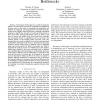Free Online Productivity Tools
i2Speak
i2Symbol
i2OCR
iTex2Img
iWeb2Print
iWeb2Shot
i2Type
iPdf2Split
iPdf2Merge
i2Bopomofo
i2Arabic
i2Style
i2Image
i2PDF
iLatex2Rtf
Sci2ools
HICSS
2007
IEEE
2007
IEEE
Modeling the Economic Cost of Transmission Bottlenecks
— The purpose of this paper is to model the stochastic behavior of nodal prices and use the predicted price differences between zones as the basis for measuring the magnitude and riskiness of congestion costs using the New York State electricity market as an example. The first step uses a principal components analysis to simplify the structure of nodal electricity prices in New York State, reducing 405 hourly prices in 2005 to less than 10 factors that explain 99% of the total price variability and correspond closely to established zones in the State. The analysis focuses on the Hudson Valley and New York City because these two zones are linked by one of the most important transmission bottlenecks in the State. A multivariate time series model for hourly temperature in different zones is estimated using data from January 1st 2000 to December 31st 2005 to represent the primary source of variability due to the weather. Multivariate models for the hourly electricity load in different z...
Biometrics | Established Zones | HICSS 2007 | Nodal Electricity Prices | Price Differences | System Sciences |
| Added | 02 Jun 2010 |
| Updated | 02 Jun 2010 |
| Type | Conference |
| Year | 2007 |
| Where | HICSS |
| Authors | Timothy D. Mount, Jaeuk Ju |
Comments (0)

